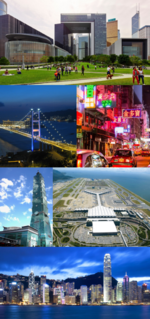Portal:Eterrum/Article: Difference between revisions
Jump to navigation
Jump to search
TheReynard (talk | contribs) (Created page with "<div style="float:left;margin:0.5em 0.9em 0.4em 0;">150px</div> Kwun San (Tung Wan: 觀山), officially known as the '''Kwun...") |
TheReynard (talk | contribs) No edit summary |
||
| (One intermediate revision by the same user not shown) | |||
| Line 1: | Line 1: | ||
<div style="float:left;margin:0.5em 0.9em 0.4em 0;">[[File: | <div style="float:left;margin:0.5em 0.9em 0.4em 0;">[[File:KwunSanSkyline.png|150px]]</div> Kwun San ([[Tungwanese language|Tung Wan]]: 觀山), officially known as the '''Kwun San Capital Area''', is the {{wp|capital}} and {{wp|primate city}} of [[Tung Wan]]. It is the seat of the [[Government of Tung Wan|national government]], and is the center of the [[Economy of Tung Wan|country's economic activity]]. As of the 2020 census, it reported a population of 11.4 million people. Combined with the cities of [[Tin Wan]] and [[Hui Po]], Kwun San forms the heart of the [[Greater Kwun San area]], a metropolitan area with a population of 19.8 million people. The city is located on the shore of [[Cheungpo Harbour]], on the central coast of Tung Wan's primary island, [[Lai Hoi Island]]. To the north of the city lies [[Kwun San Lake]], and further north, [[Mount Tin Kung]]. ('''[[Kwun San|See more...]]''') | ||
Latest revision as of 06:11, 25 November 2022
Kwun San (Tung Wan: 觀山), officially known as the Kwun San Capital Area, is the capital and primate city of Tung Wan. It is the seat of the national government, and is the center of the country's economic activity. As of the 2020 census, it reported a population of 11.4 million people. Combined with the cities of Tin Wan and Hui Po, Kwun San forms the heart of the Greater Kwun San area, a metropolitan area with a population of 19.8 million people. The city is located on the shore of Cheungpo Harbour, on the central coast of Tung Wan's primary island, Lai Hoi Island. To the north of the city lies Kwun San Lake, and further north, Mount Tin Kung. (See more...)
